Molecular Networking, Network Pharmacology, and Molecular Docking Approaches Employed to Investigate the Changes in Ephedrae Herba before and after Honey-Processing
Abstract
:1. Introduction
2. Results
2.1. HPLC-Q-TOF MS Data and MN Analysis
2.1.1. The Analysis of P1
Identification of Flavonoids and Flavonoid Glycosides
Identification of Quinolinic Acids
Identification of Phenolic Acids
Identification of Alkaloids
Others
2.1.2. The Analysis of Fraction P2
Identification of Flavonoids
Identification of Fatty Acids and Alkaloids
Others
2.2. PCA and OPLS-DA Analyses for the Identified of Discriminatory Metabolites
2.3. Network Pharmacology Analysis
2.3.1. Prediction of the Target Proteins
2.3.2. Construction of the Component-Disease-Target Network
2.3.3. Construction of the PPI Network
2.3.4. GO and KEGG Enrichment Analyses
2.4. Component-Target Molecular Docking
3. Materials and Methods
3.1. Plant Material and Chemicals
3.2. Sample Preparation for UPLC-Q-TOF-MS Analysis
3.3. UPLC-Q-TOF-MS Analysis
3.4. Establishment of Molecular Networking
3.5. Mass Spectrometry Analysis and Metabolites Annotation
3.6. Network Pharmacology
3.6.1. Construction of Networks
3.6.2. Kyoto Encyclopedia of Genes and Genomes (KEGG) and Gene Ontology (GO) Pathway Enrichment Analysis
3.7. Component-Target Molecular Docking
4. Conclusions
Supplementary Materials
Author Contributions
Funding
Institutional Review Board Statement
Informed Consent Statement
Data Availability Statement
Conflicts of Interest
Sample Availability
References
- Xiao, L. Leigong Pao Zhi Lun; Shanghai University of TCM Press: Shanghai, China, 1986. [Google Scholar]
- Wu, J.; Li, C.; Bai, L.; Wu, J.; Bo, R.; Ye, M.; Huang, L.; Chen, H.; Rui, W. Structural differences of polysaccharides from Astragalus before and after honey processing and their effects on colitis mice. Int. J. Biol. Macromol. 2021, 182, 815–824. [Google Scholar] [CrossRef] [PubMed]
- Kong, S.; Li, P.; Verpoorte, R.; Wang, J.; Zhu, C.; Dai, Y.; Chen, S. Synergistic mechanism for the bioactivity fortification of licorice by honey. J. Ethnopharmacol. 2022, 289, 115048. [Google Scholar] [CrossRef] [PubMed]
- China Pharmacopoeia Commission. Pharmacopoeia of the People’s Republic of China; China Medical Science Press: Beijing, China, 2020; Volume 1. [Google Scholar]
- Lv, Y.; Wang, S.; Liang, P.; Wang, Y.; Zhang, X.; Jia, Q.; Fu, J.; Han, S.; He, L. Screening and evaluation of anti-SARS-CoV-2 components from Ephedra sinica by ACE2/CMC-HPLC-IT-TOF-MS approach. Anal. Bioanal. Chem. 2021, 413, 2995–3004. [Google Scholar] [CrossRef] [PubMed]
- Miao, S.-M.; Zhang, Q.; Bi, X.-B.; Cui, J.-L.; Wang, M.-L. A review of the phytochemistry and pharmacological activities of Ephedra herb. Chin. J. Nat. Med. 2020, 18, 321–344. [Google Scholar] [CrossRef]
- Guo, M.; Wu, Z.; An, Q.; Li, H.; Wang, L.; Zheng, Y.; Guo, L.; Zhang, D. Comparison of Volatile Oils and Primary Metabolites of Raw and Honey-Processed Ephedrae Herba by GC–MS and Chemometrics. J. AOAC Int. 2022, 105, 576–586. [Google Scholar] [CrossRef] [PubMed]
- Wang, M.; Carver, J.J.; Phelan, V.V.; Sanchez, L.M.; Garg, N.; Peng, Y.; Nguyen, D.D.; Watrous, J.; Kapono, C.A.; Luzzatto-Knaan, T.; et al. Sharing and community curation of mass spectrometry data with Global Natural Products Social Molecular Networking. Nat. Biotechnol. 2016, 34, 828–837. [Google Scholar] [CrossRef] [PubMed] [Green Version]
- Wang, Z.; Kim, U.; Liu, J.; Cheng, C.; Wu, W.; Guo, S.; Feng, Y.; Quinn, R.J.; Hou, Y.; Bai, G. Comprehensive TCM molecular networking based on MS/MS in silico spectra with integration of virtual screening and affinity MS screening for discovering functional ligands from natural herbs. Anal. Bioanal. Chem. 2019, 411, 5785–5797. [Google Scholar] [CrossRef] [PubMed]
- Song, K.; Oh, J.-H.; Lee, M.Y.; Lee, S.-G.; Ha, I.J. Molecular Network-Guided Alkaloid Profiling of Aerial Parts of Papaver nudicaule L. Using LC-HRMS. Molecules 2020, 25, 2636. [Google Scholar] [CrossRef] [PubMed]
- Lv, X.; Xu, Z.; Xu, G.; Li, H.; Wang, C.; Chen, J.; Sun, J. Investigation of the active components and mechanisms of Schisandra chinensis in the treatment of asthma based on a network pharmacology approach and experimental validation. Food Funct. 2020, 11, 3032–3042. [Google Scholar] [CrossRef] [PubMed]
- Zhang, Y.; Shi, G.; Luo, Z.; Wang, J.; Wu, S.; Zhang, X.; Zhao, Y. Activity Components from Gynostemma pentaphyllum for Preventing Hepatic Fibrosis and of Its Molecular Targets by Network Pharmacology Approach. Molecules 2021, 26, 3006. [Google Scholar] [CrossRef] [PubMed]
- Pinzi, L.; Rastelli, G. Molecular Docking: Shifting Paradigms in Drug Discovery. Int. J. Mol. Sci. 2019, 20, 4331. [Google Scholar] [CrossRef] [PubMed] [Green Version]
- Zhang, K.; Han, M.; Zhao, X.; Chen, X.; Wang, H.; Ni, J.; Zhang, Y. Hypoglycemic and Antioxidant Properties of Extracts and Fractions from Polygoni Avicularis Herba. Molecules 2022, 27, 3381. [Google Scholar] [CrossRef]
- Kaszuba, J.; Kapusta, I.; Posadzka, Z. Content of Phenolic Acids in the Grain of Selected Polish Triticale Cultivars and Its Products. Molecules 2021, 26, 562. [Google Scholar] [CrossRef]
- Qu, C.; Yin, N.; Chen, S.; Wang, S.; Chen, X.; Zhao, H.; Shen, S.; Fu, F.; Zhou, B.; Xu, X.; et al. Comparative Analysis of the Metabolic Profiles of Yellow-versus Black-Seeded Rapeseed Using UPLC–HESI–MS/MS and Transcriptome Analysis. J. Agric. Food Chem. 2020, 68, 3033–3049. [Google Scholar] [CrossRef] [PubMed]
- Pan, J.; Yang, Q.; Zhou, Y.; Deng, H.; Zhu, Y.; Zhao, D.; Liu, F. MicroRNA-221 Modulates Airway Remodeling via the PI3K/AKT Pathway in OVA-Induced Chronic Murine Asthma. Front. Cell Dev. Biol. 2020, 8, 495. [Google Scholar] [CrossRef] [PubMed]
- Zhu, Y.; Sun, D.; Liu, H.; Sun, L.; Jie, J.; Luo, J.; Peng, L.; Song, L. Bixin protects mice against bronchial asthma though modulating PI3K/Akt pathway. Int. Immunopharmacol. 2021, 101, 108266. [Google Scholar] [CrossRef] [PubMed]
- Liao, Z.; Zhang, J.; Liu, B.; Yan, T.; Xu, F.; Xiao, F.; Wu, B.; Bi, K.; Jia, Y. Polysaccharide from Okra (Abelmoschus esculentus (L.) Moench) Improves Antioxidant Capacity via PI3K/AKT Pathways and Nrf2 Translocation in a Type 2 Diabetes Model. Molecules 2019, 24, 1906. [Google Scholar] [CrossRef] [PubMed] [Green Version]
- Yahfoufi, N.; Alsadi, N.; Jambi, M.; Matar, C. The Immunomodulatory and Anti-Inflammatory Role of Polyphenols. Nutrients 2018, 10, 1618. [Google Scholar] [CrossRef] [PubMed] [Green Version]
- Yeung, Y.T.; Aziz, F.; Guerrero-Castilla, A.; Arguelles, S. Signaling pathways in inflammation and anti-inflammatory therapies. Curr. Pharm. Des. 2018, 24, 1449–1484. [Google Scholar] [CrossRef] [PubMed]
- Bitencourt-Ferreira, G.; Pintro, V.O.; Azevedo, W.F.D. Docking with autodock4. In Docking Screens for Drug Discovery; Springer: New York, NY, USA, 2019; pp. 125–148. [Google Scholar]
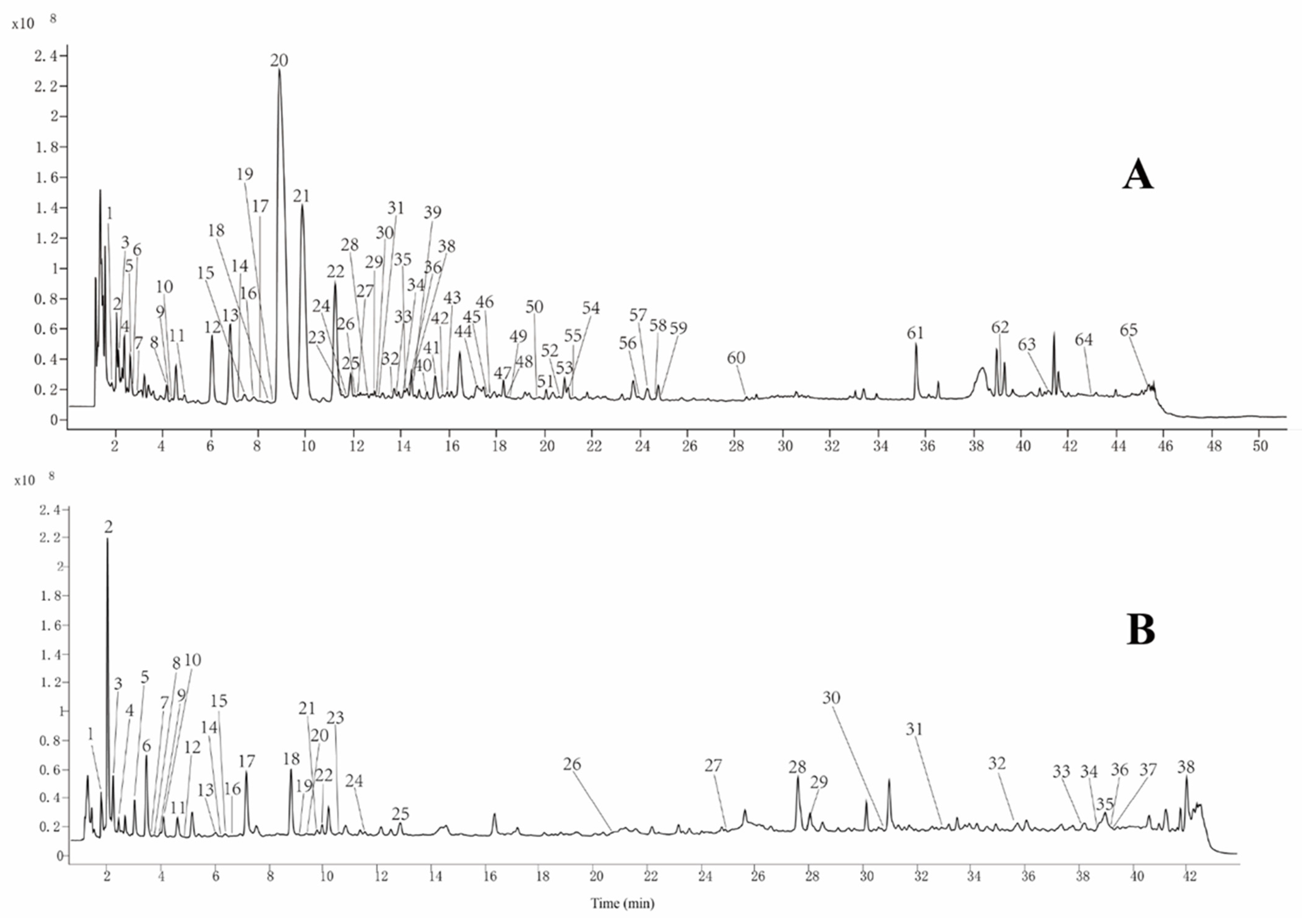
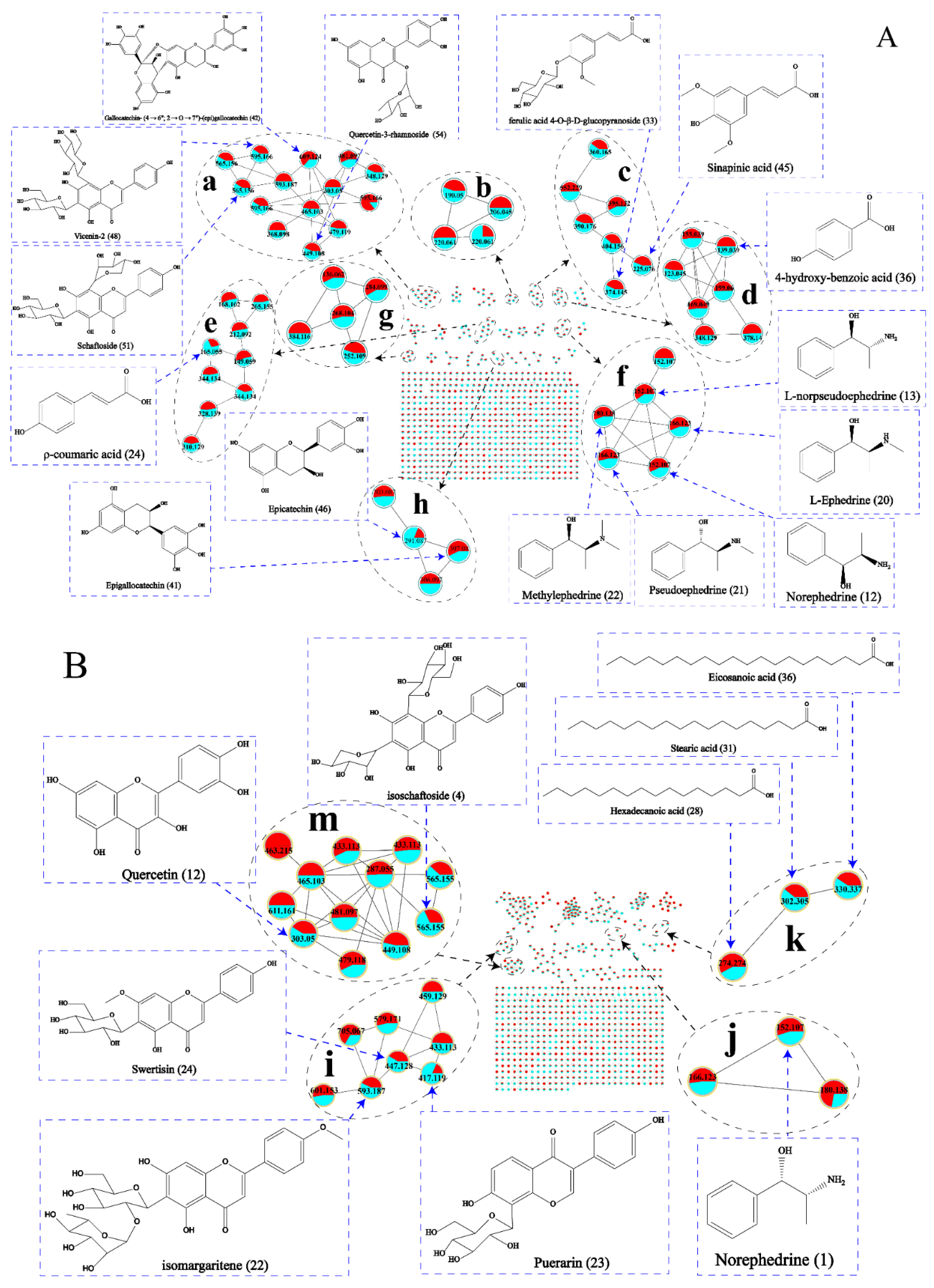
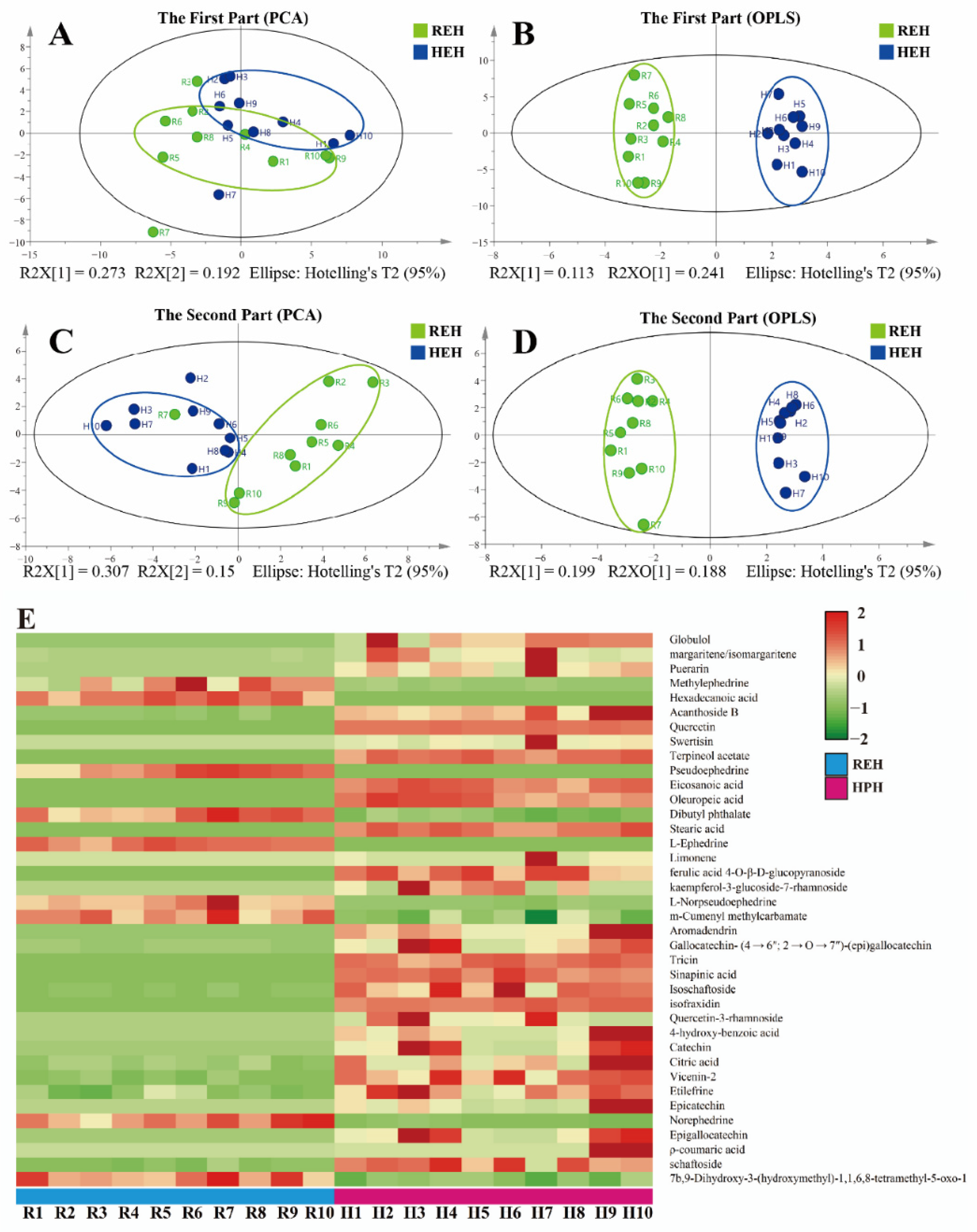
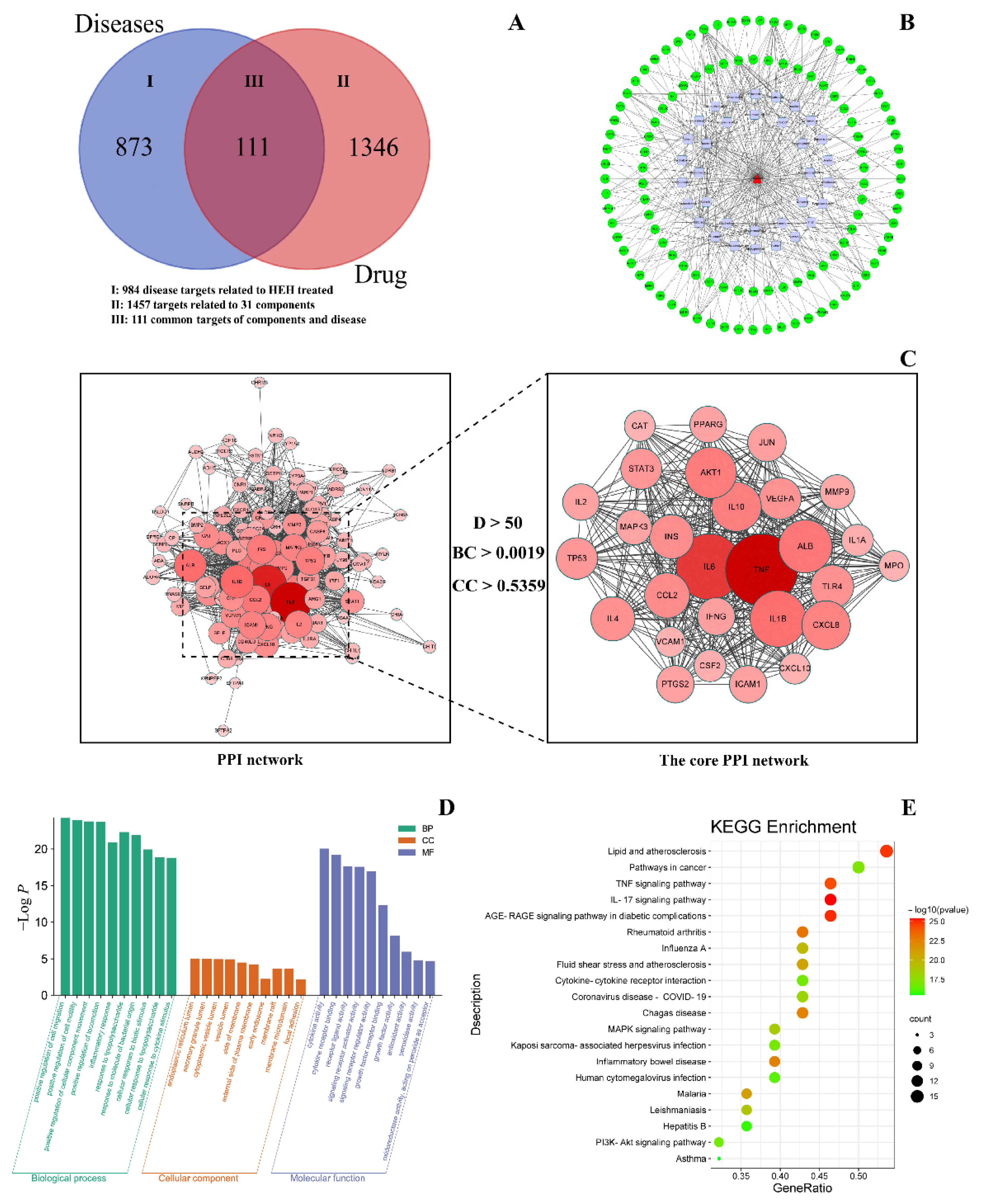
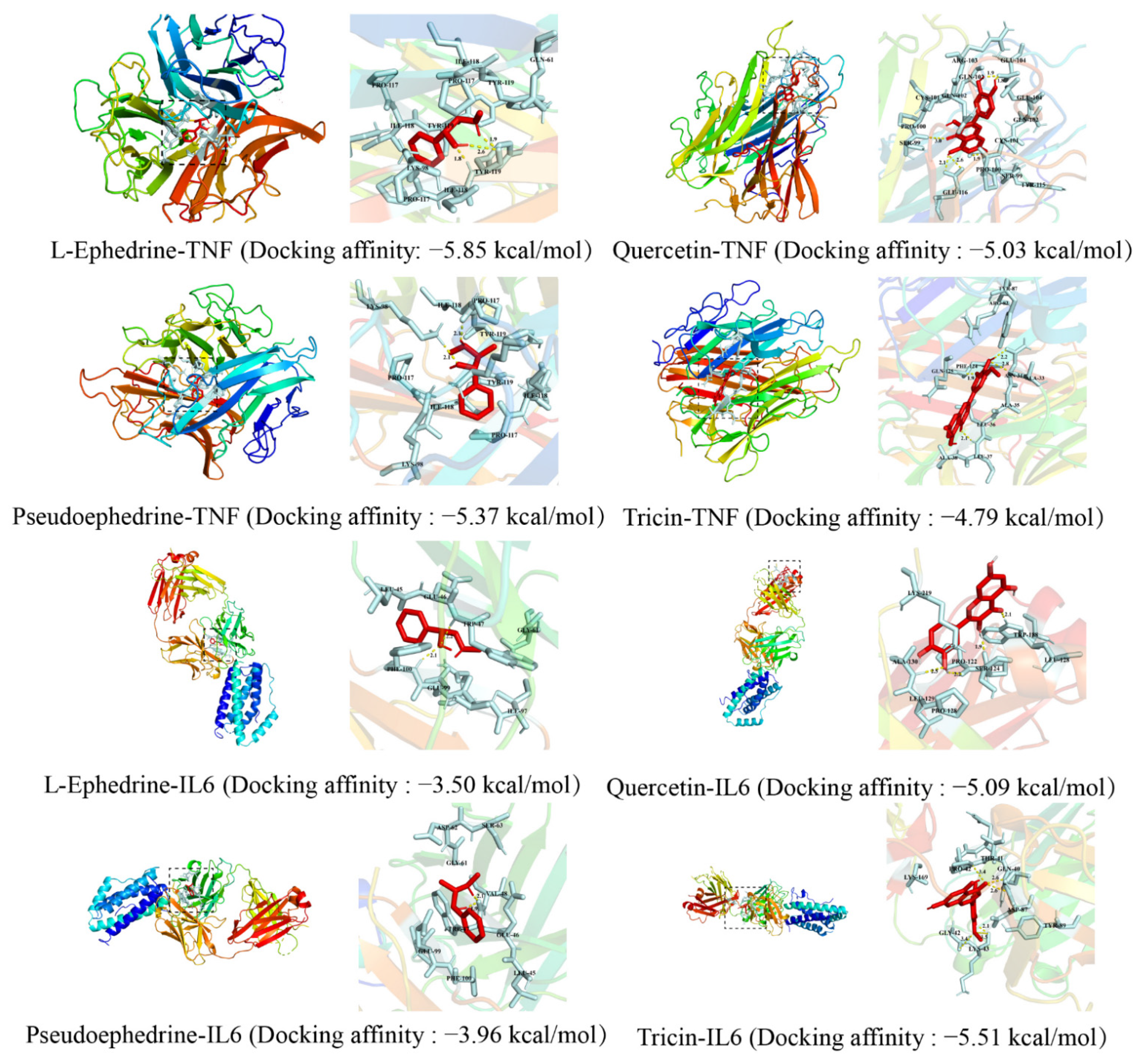
| No. | tR (min) | Molecular Formula | Quasi-Molecular | MS/MS Fragments | Error (ppm) | Identification |
|---|---|---|---|---|---|---|
| 1 | 1.88 | C5H5N5 | [M + H]+ 136.0621 | 109.0499; 119.0349; 136.0621 | 2.43 | Adenine |
| 2& | 2.06 | C6H8O7 | [M + NH4]+ 210.0612 | 193.1207; 175.0588; 113.9623 | 1.94 | Citric acid |
| 3 | 2.16 | C15H18O8 | [M + H]+ 344.1342 | 327.1263; 344.0911; 165.0544; 147.0455; 119.0492 | 0.6 | O-Coumaric acid glucoside |
| 4 | 2.41 | C10H13N5O4 | [M + H]+ 268.1045 | 161.0431; 136.0619; 119.0350 | 1.76 | Adenosine |
| 5 | 2.68 | C10H10O4 | [M + NH4]+ 212.0923 | 212.0922; 194.0809; 152.0706; 134.0599 | 2.91 | Ferulic Acid |
| 6 | 2.68 | C10H13N5O5 | [M + H]+ 284.0992 | 152.0566 | 0.9 | Isoguanosine |
| 7 | 2.69 | C10H13N5O3 | [M + H]+ 252.1092 | 136.0619 | 0.34 | Cordycepin |
| 8 | 4.14 | C17H24O7 | [M + H]+ 358.1864 | 340.1748; 179.2667; 162.7284 | 1.04 | Nebrodenside A |
| 9& | 4.16 | C10H15NO2 | [M + H]+ 182.1178 | 182.1178; 164.1069 | 1.35 | Etilefrine |
| 10 | 4.34 | C15H18O7 | [M + NH4]+ 328.1393 | 311.1288; 132.0810 | 0.71 | 4-β-d-glucopyranosyloxy-trans-Cinnamaldehyde |
| 11 | 4.94 | C9H10O2 | [M + NH4]+ 168.1021 | 105.0702; 133.0647 | 1.3 | 4-Vinylguaiacol |
| 12& | 6.07 | C9H13NO | [M + H]+ 152.107 | 152.1118; 134.0964; 117.0695 | 0.06 | Norephedrine |
| 13& | 6.83 | C9H13NO | [M + H]+ 152.107 | 152.1118; 134.0964; 117.0695 | 0.06 | l-norpseudoephedrine |
| 14& | 7.20 | C17H14O7 | [M + NH4]+ 348.1291 | 331.1776; 314.2340 | −2.06 | Tricin |
| 15 | 7.40 | C15H14O7 | [M + H]+ 307.0815 | 223.0600; 205.0504; 195.0645; 181.0474; 177.0554; 169.0510; 139.0388; 127.0389 | 0.88 | Gallocatechin |
| 16 | 7.74 | C7H6O4 | [M + H]+ 155.0338 | 140.0594; 138.0553; 137.0229; 111.0439; 110.0604; 109.0280 | −0.55 | Protocatechuic acid |
| 17 | 8.05 | C14H18O9 | [M + NH4]+ 348.1287 | 169.0491 | −0.6 | Pseudolaroside B |
| 18 | 8.07 | C8H8O4 | [M + H]+ 169.0495 | 152.0703; 112.9556; 110.0086 | −0.21 | Vanillic acid |
| 19 | 8.75 | C10H7NO4 | [M + H]+ 206.0451 | 178.0467; 162.0442; 160.0394 | 1.54 | 6-hydroxykynurenic acid |
| 20& | 9.04 | C10H15NO | [M + H]+ 166.1229 | 148.1120; 133.0886; 117.0698 | 1.57 | l-ephedrine |
| 21& | 9.91 | C10H15NO | [M + H]+ 166.1229 | 148.1120; 133.0886; 117.0698 | 1.57 | Pseudoephedrine |
| 22& | 11.25 | C11H17NO | [M + H]+ 180.1384 | 180.1384; 162.1277; 147.1047; 117.0701 | 0.61 | Methylephedrine |
| 23 | 11.53 | C14H20N2O3 | [M + H]+ 265.1548 | 265.1520; 177.0544; 145.0279; 117.0322 | 0.5 | (trans)cis-N-feruloylputrescine |
| 24 | 11.55 | C9H8O3 | [M + H]+ 165.0547 | 137.1092; 124.0850; 121.0637; 115.0537; 102.0356 | 0.48 | ρ-coumaric acid |
| 25 | 11.87 | C13H18N4O3 | [M + H]+ 279.1454 | 279.1456; 220.0974; 105.0332 | 0.84 | N″-benzoyl-l-arginine |
| 26& | 12.03 | C9H10O5 | [M + H]+ 199.0601 | 182.0524; 165.0140; 140.0472; 125.0958 | 0 | Syringic acid |
| 27 | 12.03 | C15H20O10 | [M + NH4]+ 378.1399 | 199.0594; 155.0703 | 1.19 | Glucosyringic acid |
| 28 | 12.58 | C7H6O2 | [M + H]+ 123.0445 | 123.0427; 108.0618; 106.0732 | 3.64 | Benzoic acid |
| 29 | 12.87 | C23H34O14 | [M + NH4]+ 552.2287 | 193.0859; 161.0595 | 0.03 | Isosyringinoside |
| 30 | 12.88 | C11H12O3 | [M + H]+ 193.0861 | 161.0602; 136.0738 | 0.93 | Myristicin |
| 31 | 12.95 | C10H7NO3 | [M + H]+ 190.0497 | 162.0318; 144.0440 | −0.9 | Kynurenic acid |
| 32 | 13.66 | C16H14O6 | [M + H]+ 303.0867 | 151.0384; 153.0558; 137.0602; 119.0493; 123.0434 | 1.28 | Hesperetin/Homoeriodictyol |
| 33& | 13.71 | C16H20O9 | [M + NH4]+ 374.1446 | 195.0648; 151.0743; 177.0549 | 0.12 | Ferulic acid 4-O-β-d-glucopyranoside |
| 34 | 14.10 | C9H8O3 | [M + H]+ 165.0547 | 121.0745; 119.0740; 117.0691 | 0.48 | o-coumaric acid |
| 35& | 14.10 | C15H18O8 | [M + NH4]+ 344.1342 | 344.0911; 326.1246; 165.0544; 149.0785; 119.0492 | 0.6 | ρ-coumaric acid glucoside |
| 36& | 14.21 | C7H6O3 | [M + H]+ 139.0397 | 139.0389; 122.0957; 111.0442 | 5.28 | 4-hydroxy-benzoic acid |
| 37& | 14.23 | C15H14O6 | [M + H]+ 291.0867 | 291.0870; 165.0539; 139.0392 | 1.33 | Catechin |
| 38& | 14.23 | C15H12O6 | [M + NH4]+ 306.0973 | 289.0693; 261.1972; 179.0330; 153.0532 | 0.3 | Aromadendrin |
| 39 | 14.41 | C17H24O9 | [M + NH4]+ 390.1764 | 211.0956 | 1.46 | Syringin |
| 40 | 15.06 | C17H22O10 | [M + NH4]+ 404.1558 | 225.0758; 207.0653; 192.0405 | 1.75 | 1-O-β-d-glucopyranosyl sinapate |
| 41& | 15.36 | C15H14O7 | [M + H]+ 307.0815 | 223.0600; 205.0504; 195.0645; 177.0554; 169.0510; 139.0388; | 0.88 | Epigallocatechin |
| 42& | 15.75 | C30H24O14 | [M + H]+ 609.1241 | 441.0809; 303.0499 | 0.36 | Gallocatechin- (4 → 6″; 2 → O → 7″)-(epi)gallocatechin |
| 43 | 15.93 | C9H8O2 | [M + H]+ 149.0596 | 104.0579; 131.0496 | −0.72 | Cinnamic acid |
| 44 | 17.14 | C11H9NO4 | [M + H]+ 220.0609 | 220.0598; 202.0485; 174.0553; 146.0598 | 2.13 | 6-methoxykynurenic acid |
| 45 | 17.63 | C11H12O5 | [M + H]+ 225.076 | 225.0761; 181.0817; 151.0377 | 1.12 | Sinapinic acid |
| 46& | 17.66 | C15H14O6 | [M + H]+ 291.0867 | 134.0966; 117.0697; 115.0542; 106.0655 | 1.33 | Epicatechin |
| 47& | 18.28 | C10H16 | [M + H]+ 137.1326 | 137.0626; 121.0406; 107.0847 | 0.9 | Limonene |
| 48& | 18.31 | C27H30O15 | [M + H]+ 595.1661 | 577.1549; 457.1129; 379.0810; 337.0708 | 0.59 | Vicenin-2 |
| 49 | 18.48 | C8H8O3 | [M + H]+ 153.0546 | 109.0647; 135.0433; 125.0953 | −0.14 | 4-hydroxyphenylacetic acid |
| 50& | 19.77 | C27H30O15 | [M + H]+ 595.1661 | 287.0552; 449.1089; 329.0275; | 0.59 | kaempferol-3-glucoside-7-rhamnoside |
| 51& | 20.09 | C26H28O14 | [M + H]+ 565.1556 | 565.1516; 475.1224; 445.1148; 355.0911; | 0.74 | Schaftoside |
| 52 | 20.67 | C32H44O16 | [M + NH4]+ 702.2963 | 331.1540; 343.1572; | 1.74 | 3-[2-(4-Hydroxy-3-methoxyphenyl)-3-[[2-O-(beta-d-glucopyranosyl)-alpha-d-glucopyranosyloxy] methyl]-7-methoxy-2,3-dihydrobenzofuran-5-yl]-1-propanol |
| 53& | 20.87 | C26H28O14 | [M + H]+ 565.1556 | 565.1516; 475.1224; 445.1148; 355.0911 | 0.74 | Isoschaftoside |
| 54& | 21.02 | C21H20O11 | [M + H]+ 449.1082 | 299.0555; 109.0273; 153.0572; 229.0473; 272.9334 | 0.81 | Quercetin-3-rhamnoside |
| 55 | 21.17 | C27H30O15 | [M + H]+ 595.1661 | 287.0552; 449.1089; 329.0275 | 0.59 | Kaempferol-3-O-rhamnoside 7-Oglucoside |
| 56 | 23.94 | C10H8O4 | [M + H]+ 193.0497 | 193.0507; 178.0266; 149.0239; 133.0293; 121.0658 | 0.86 | Scopoletin |
| 57 | 24.40 | C26H34O11 | [M + NH4]+ 540.2447 | 493.1487; 239.1038 | 1.46 | Urolignoside |
| 58 | 24.79 | C21H20O12 | [M + H]+ 465.1034 | 303.0503; 257.0440; 153.0187 | 1.4 | Hyperoside |
| 59& | 24.79 | C15H10O7 | [M + H]+ 303.0504 | 257.0445; 229.0494; 285.0392; 303.0501 | 1.56 | Quercetin |
| 60 | 28.55 | C22H22O12 | [M + H]+ 479.1196 | 363.2410; 317.0653; 302.0433; 255.0016; 245.0436 | 0.41 | Isorhamnetin-3-O-glucoside |
| 61& | 35.94 | C12H20O2 | [M + NH4]+ 214.1806 | 136.1056 | 2.27 | Terpineol acetate |
| 62& | 39.17 | C16H32O2 | [M + NH4]+ 274.2741 | 274.2738; 257.2679; 226.1808; 212.2357; 197.0965 | 0.17 | Hexadecanoic acid |
| 63& | 41.15 | C11H15NO2 | [M + H]+ 194.1175 | 137.0566; 194.1180 | −0.29 | m-Cumenyl methylcarbamate |
| 64& | 42.97 | C11H10O5 | [M + H]+ 223.0603 | 223.0609; 208.0361; 163.0394 | 0.9 | Isofraxidin |
| 65 | 45.71 | C22H43NO | [M + H]+ 338.3419 | 149.1355; 212.2030; 303.3041; 338.3424 | 0.47 | Erucylamide |
| No. | tR (min) | Molecular Formula | Quasi-Molecular | MS/MS Fragments | Error (ppm) | Identification |
|---|---|---|---|---|---|---|
| 1& | 1.822 | C9H13NO | [M + H]+ 152.107 | 152.1118; 134.0964; 117.0695 | 0.06 | Norephedrine |
| 2& | 2.022 | C10H15NO | [M + H]+ 166.123 | 166.1230; 148.1121; 133.0887; 117.0697 | 2.18 | l-ephedrine/Pseudoephedrine |
| 3& | 2.222 | C11H17NO | [M + H]+ 180.1384 | 180.1384; 162.1277; 147.1047; 117.0701 | 0.61 | Methylephedrine |
| 4& | 2.521 | C26H28O14 | [M + H]+ 565.1552 | 565.1552; 475.1048; 445.1132; 355.0797 | 0.03 | Isoschaftoside/schaftoside |
| 5 | 2.971 | C21H20O13 | [M + H]+ 481.0976 | 319.0443; 273.0312 | −0.14 | Myricetin-3-Galactoside |
| 6 | 3.337 | C27H30O14 | [M + H]+ 579.1711 | 579.2605; 433.1123; 283.0597 | 0.46 | Vitexin-2-rhamnoside |
| 7 | 3.354 | C21H20O10 | [M + H]+ 433.1133 | 433.1151; 271.0591 | 0.87 | Apigenin-7-O-glucoside |
| 8 | 3.637 | C27H30O16 | [M + H]+ 611.1607 | 611.2231; 465.1023; 303.0502 | 0.06 | Rutin |
| 9& | 3.853 | C10H16 | [M + H]+ 137.1325 | 107.0846; 121.0391; 137.1087 | 0.17 | Limonene |
| 10 | 3.970 | C21H20O10 | [M + H]+ 433.1133 | 433.1149; 415.1036; 313.0710; 283.0604; 397.0921; 379.0809; 337.0714 | 0.87 | Vitexin/Isovitexin |
| 11 | 4.452 | C21H20O12 | [M + H]+ 465.1031 | 303.0501; 257.0445; 137.0235; 153.0178 | 0.75 | Hyperoside |
| 12& | 4.452 | C15H10O7 | [M + H]+ 303.0504 | 257.0445; 229.0494; 285.0392; 303.0501 | 1.56 | Quercetin |
| 13 | 6.001 | C26H34O11 | [M + NH4]+ 540.2434 | 331.1534; 313.1419; 287.1281; 151.0755; 137.0573 | −1.03 | 2-(Hydroxymethyl)-6-[5-[3-(hydroxymethyl)-5-(3-hydroxypropyl)-7-methoxy-2,3-dihydro-1-benzofuran-2-yl]-2-methoxyphenoxy]oxane-3,4,5-triol |
| 14 | 6.217 | C9H8O2 | [M + H]+ 149.0597 | 149.0597; 105.0352 | −0.04 | Cinnamic acid/Trans-cinnamic acid |
| 15& | 6.578 | C28H36O13 | [M + NH4]+ 598.2492 | 401.1590; 205.0859 | −0.37 | Acanthoside B |
| 16& | 6.700 | C21H20O11 | [M + H]+ 449.1082 | 299.0555; 109.0273; 153.0572; 229.0473; 272.9334 | 0.81 | Quercetin-3-rhamnoside |
| 17 | 7.100 | C19H32O7 | [M + H]+ 373.222 | 135.1167; 175.1474; 193.1586; 211.1688 | −0.21 | Byzantionoside B |
| 18 | 8.831 | C11H12O4 | [M + H]+ 209.0809 | 177.0544; 191.0697; 121.0643 | 0.31 | Sinapaldehyde |
| 19 | 9.597 | C20H26O6 | [M-H2O + H]+ 327.1590 | 137.0599; 163.0747; 133.0647; 138.0630 | −0.26 | Secoisolariciresinol |
| 20 | 9.547 | C15H10O6 | [M + H]+ 287.0551 | 153.0184; 287.0575; 213.0544; 165.0159 | 0.3 | Kaempferol |
| 21 | 9.564 | C21H20O10 | [M + H]+ 433.1133 | 287.0554; 286.0484 | 0.87 | Kaempferol-3-rhamnoside |
| 22& | 9.714 | C28H32O14 | [M + H]+ 593.1868 | 593.1819; 473.1448; 447.1285; 429.1186; 285.0742 | 0.54 | Margaritene/isomargaritene |
| 23& | 10.396 | C21H20O9 | [M + H]+ 417.1192 | 417.1225; 399.1037; 381.0957 | 2.86 | Puerarin |
| 24& | 11.528 | C22H22O10 | [M + H]+ 447.1285 | 297.0758; 327.0871; 447.1264 | −0.16 | Swertisin |
| 25 | 12.610 | C16H28O6 | [M + H]+ 317.1957 | 137.1327 | −0.52 | (−)-α-terpineol-8-O-β-d-glucopyranoside |
| 26& | 20.452 | C12H20O2 | [M + NH4]+ 214.1803 | 136.1207 | 0.74 | Terpineol acetate |
| 27 | 24.881 | C17H17ClO6 | [M + H]+ 353.0788 | 165.0544; 215.0100; 285.0529; 353.0781 | 0.45 | Griseofulvin |
| 28 | 27.511 | C16H32O2 | [M + H]+274.2741 | 196.9640; 257.2673; 274.2741 | 0.16 | Hexadecanoic acid |
| 29& | 27.911 | C15H26O | [M + NH4]+ 240.2323 | 107.0848; 109.1002 | 0.49 | Globulol |
| 30& | 30.741 | C22H30O6 | [M + CAN + H]+ 432.2378 | 119.0853; 135.0799; 147.0643; 281.1375; 107.0855 | - | 7b,9-Dihydroxy-3-(hydroxymethyl)-1,1,6,8-tetramethyl-5-oxo-1,1a,1b,4,4a,5,7a,7b,8,9-decahydro-9aH-cyclopropa[3,4]benzo[1,2-e]azulen-9a-yl acetate |
| 31& | 32.922 | C18H36O2 | [M + NH4]+ 302.3053 | 302.3055; 285.2978; 241.2370 | −0.2 | Stearic acid |
| 32 | 35.869 | C18H30O2 | [M + H]+ 279.2319 | 237.9922; 109.101 | 0.16 | Linolenic acid |
| 33& | 38.000 | C10H16O3 | [M + H]+ 185.1172 | 111.0443 | −0.66 | Oleuropeic acid |
| 34 | 38.500 | C18H32O2 | [M + NH4]+ 298.2742 | 298.2742; 281.1532; 263.2369; 245.2253; 239.2349 | 0.51 | 9,12-Linoleic acid |
| 35& | 38.833 | C16H22O4 | [M + H]+ 279.1594 | 149.0232; 150.0268; 223.9774; 279.1594 | 1.13 | Dibutyl phthalate |
| 36& | 38.833 | C20H40O2 | [M + NH4]+ 330.337 | 257.1545; 227.1744; 330.3365; 312.3233 | 1.1 | Eicosanoic acid |
| 37 | 39.066 | C18H34O3 | [M + H]+ 321.2425 | 119.0856; 151.1119; 133.1012; 161.0931 | 0.25 | (E)-6-hydroxyoctadec-4-enoic acid |
| 38 | 42.046 | C22H43NO | [M + H]+ 338.3418 | 338.3410; 303.3043; 212.2006; 149.1316 | 0.17 | Erucylamide |
| Classification | No. | Name | Degree | Closeness Centrality | Betweenness Centrality |
|---|---|---|---|---|---|
| Core components | 1 | Quercetin | 52 | 0.4814 | 0.1050 |
| 2 | Citric acid | 35 | 0.4316 | 0.0524 | |
| 3 | Puerarin | 20 | 0.3767 | 0.0120 | |
| 4 | Epicatechin | 15 | 0.3827 | 0.0091 | |
| 5 | l-Ephedrine | 15 | 0.3807 | 0.0101 | |
| 6 | Pseudoephedrine | 13 | 0.3747 | 0.0055 | |
| 7 | Norephedrine | 12 | 0.3559 | 0.0050 | |
| 8 | Tricin | 12 | 0.3727 | 0.0071 | |
| Core targets | 1 | TNF | 85 | 0.7943 | 0.0543 |
| 2 | IL6 | 84 | 0.7832 | 0.0588 | |
| 3 | IL1B | 79 | 0.7568 | 0.0459 | |
| 4 | ALB | 76 | 0.7467 | 0.0570 | |
| 5 | AKT1 | 74 | 0.7368 | 0.0468 | |
| 6 | IL10 | 72 | 0.7226 | 0.0267 | |
| 7 | CXCL8 | 71 | 0.7179 | 0.0195 | |
| 8 | CCL2 | 67 | 0.6957 | 0.0151 | |
| 9 | INS | 66 | 0.6957 | 0.0199 | |
| 10 | IL4 | 66 | 0.6914 | 0.0300 |
| Sample | Botanical Origin | Collection Area |
|---|---|---|
| REH-1 | Ephedra sinica Stapf | Hebei Hou Xiaobin Chinese Medicine Clinic |
| REH-2 | Hebei Tian Chunji Chinese Medicine Clinic | |
| REH-3 | Hebei Zhizi Pharmacy on Hongqi Street | |
| REH-4 | Hebei Bai xingkang Pharmacy | |
| REH-5 | Hebei Tongrentang pharmacy | |
| REH-6 | Hebei Emerging pharmacy | |
| REH-7 | Hebei Shenwei Pharmacy | |
| REH-8 | Hebei Lerentang Pharmacy | |
| REH-9 | Hebei Anguo Market | |
| REH-10 | Hebei Guoyitang Pharmacy |
Publisher’s Note: MDPI stays neutral with regard to jurisdictional claims in published maps and institutional affiliations. |
© 2022 by the authors. Licensee MDPI, Basel, Switzerland. This article is an open access article distributed under the terms and conditions of the Creative Commons Attribution (CC BY) license (https://creativecommons.org/licenses/by/4.0/).
Share and Cite
Li, H.; Guo, L.; Ding, X.; An, Q.; Wang, L.; Hao, S.; Li, W.; Wang, T.; Gao, Z.; Zheng, Y.; et al. Molecular Networking, Network Pharmacology, and Molecular Docking Approaches Employed to Investigate the Changes in Ephedrae Herba before and after Honey-Processing. Molecules 2022, 27, 4057. https://doi.org/10.3390/molecules27134057
Li H, Guo L, Ding X, An Q, Wang L, Hao S, Li W, Wang T, Gao Z, Zheng Y, et al. Molecular Networking, Network Pharmacology, and Molecular Docking Approaches Employed to Investigate the Changes in Ephedrae Herba before and after Honey-Processing. Molecules. 2022; 27(13):4057. https://doi.org/10.3390/molecules27134057
Chicago/Turabian StyleLi, Hengyang, Long Guo, Xiaoying Ding, Qi An, Lei Wang, Shenghui Hao, Wenjie Li, Tao Wang, Zetong Gao, Yuguang Zheng, and et al. 2022. "Molecular Networking, Network Pharmacology, and Molecular Docking Approaches Employed to Investigate the Changes in Ephedrae Herba before and after Honey-Processing" Molecules 27, no. 13: 4057. https://doi.org/10.3390/molecules27134057
APA StyleLi, H., Guo, L., Ding, X., An, Q., Wang, L., Hao, S., Li, W., Wang, T., Gao, Z., Zheng, Y., & Zhang, D. (2022). Molecular Networking, Network Pharmacology, and Molecular Docking Approaches Employed to Investigate the Changes in Ephedrae Herba before and after Honey-Processing. Molecules, 27(13), 4057. https://doi.org/10.3390/molecules27134057






